rockfish
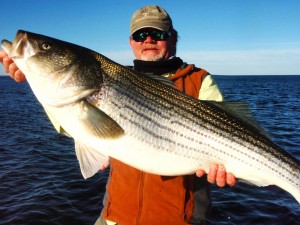 If the next 51 weeks of 2012 go as well as the first one, this promises to be a very good year for light tackle fishing on the Chesapeake Bay. I’ve fished four times and caught a Diamond Jim qualifying citation fish on each trip including three rockfish in the mid 40-inch range. I’m chalking it up to a little experience, some insider information, and a lot of luck. My son, “Big Fish Cory” has been visiting. Although he didn’t catch any trophies this time around, he still brought along his lucky horseshoe. Chesapeake striped bass fishermen have two basic winter options. One is to fish deep holes – either in the main stem of the Bay or up in the outside bends of the rivers – and the other is to work the warm water discharges. Since we’ve had a very mild winter so far, the warm water discharges have been inconsistent. I decided to split the difference and fish the last four days close to home off Kent Island.
If the next 51 weeks of 2012 go as well as the first one, this promises to be a very good year for light tackle fishing on the Chesapeake Bay. I’ve fished four times and caught a Diamond Jim qualifying citation fish on each trip including three rockfish in the mid 40-inch range. I’m chalking it up to a little experience, some insider information, and a lot of luck. My son, “Big Fish Cory” has been visiting. Although he didn’t catch any trophies this time around, he still brought along his lucky horseshoe. Chesapeake striped bass fishermen have two basic winter options. One is to fish deep holes – either in the main stem of the Bay or up in the outside bends of the rivers – and the other is to work the warm water discharges. Since we’ve had a very mild winter so far, the warm water discharges have been inconsistent. I decided to split the difference and fish the last four days close to home off Kent Island.
One of the best places I know of to jig up deep water rockfish is the Bay Bridge. Two- and three-year-old-stripers and white perch survive the cold winter by stacking up around the Bay Bridge rock piles. They’ll stay there until the spring freshet washes out their warm water comfort zones. Even though they are readily apparent on a fish finder, they aren’t always easy to catch. To coax a strike out of deep-water stripers you just have to aggravate them until they bite. You can jig for hours and not get a single strike, then, snap – the fish will turn on and you’re catching every cast. Read More!
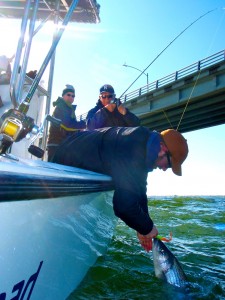 I’ve just spent an extra long, extra fun weekend at the Chesapeake Bay Bridge Tunnel (CBBT). Connecting the Delmarva Peninsula with Norfolk and Virginia Beach, the CBBT is 23 miles of high-current structure that is prime habitat for striped bass. Rich Jenkins and I trailered my Judge 27 center console Thunder Road down Rt 13 to Cape Charles late last Friday. My son Daniel and my brother-in-law Mitch flew into Norfolk to meet us. We had a great time and found some fine fishing.
I’ve just spent an extra long, extra fun weekend at the Chesapeake Bay Bridge Tunnel (CBBT). Connecting the Delmarva Peninsula with Norfolk and Virginia Beach, the CBBT is 23 miles of high-current structure that is prime habitat for striped bass. Rich Jenkins and I trailered my Judge 27 center console Thunder Road down Rt 13 to Cape Charles late last Friday. My son Daniel and my brother-in-law Mitch flew into Norfolk to meet us. We had a great time and found some fine fishing.
In Decembers past I’ve stayed at hotels in the Kiptopeke area but this time I decided to look into renting a vacation home for our four night stay. After calling and emailing several places, I settled on a house in historic Cape Charles called “Southern Comfort on the Bay.” A recently remodeled Victorian with three bedrooms, two baths, a kitchen, game room, washer and dryer and a driveway large enough to park my boat in, it was the perfect base for our five days of fishing. It’s very nice to come off the water and have a roomy place to kick back, dry our clothes, watch football, play cards, and enjoy good food and drink. Better still was the price. I’ve paid more for a single hotel room. Read More!
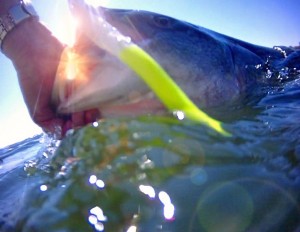 Thanks to everyone who made it to the re-creation of the Annapolis chapter of the Coastal Conservation Association (CCA) at the Boatyard Bar & Grill last night. There was a big turnout and we had a lot of fun. As I was driving to the meeting, I considered the concept of re-creating something as significant as a major chapter in a national conservation group. It’s obviously an important event, so I decided to collect my thoughts on the concept of re-creating. I looked up the word recreation and found that it simply means to create something anew. I suppose almost everyone who reads this website considers themselves recreational fishermen. The time we spend on and around the water helps us wind down and relax. So by fishing, we’re essentially restoring ourselves to a state-of-mind that makes it easier to face the daily challenges life throws our way. Read More!
Thanks to everyone who made it to the re-creation of the Annapolis chapter of the Coastal Conservation Association (CCA) at the Boatyard Bar & Grill last night. There was a big turnout and we had a lot of fun. As I was driving to the meeting, I considered the concept of re-creating something as significant as a major chapter in a national conservation group. It’s obviously an important event, so I decided to collect my thoughts on the concept of re-creating. I looked up the word recreation and found that it simply means to create something anew. I suppose almost everyone who reads this website considers themselves recreational fishermen. The time we spend on and around the water helps us wind down and relax. So by fishing, we’re essentially restoring ourselves to a state-of-mind that makes it easier to face the daily challenges life throws our way. Read More!
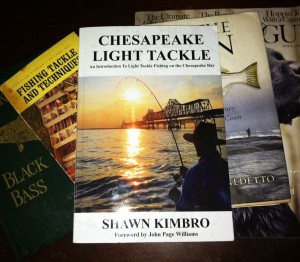 On December 6, I will unofficially release my book, Chesapeake Light Tackle – A Introduction to Light Tackle Fishing on the Chesapeake Bay. I’m very excited. The challenge, of course, will be selling it. Since many brick and mortar bookstores are closing, and big national chains like Borders are going under, you may be wondering why in the world anyone would want to put words down on real paper pages. I’ve been asking myself that question, especially since it’s a whole lot easier to relay my fishing stories and technique tips via this website. When you think about it, the medium doesn’t really matter too much as long as the information is up-to-date and reliable. So, why a book?
On December 6, I will unofficially release my book, Chesapeake Light Tackle – A Introduction to Light Tackle Fishing on the Chesapeake Bay. I’m very excited. The challenge, of course, will be selling it. Since many brick and mortar bookstores are closing, and big national chains like Borders are going under, you may be wondering why in the world anyone would want to put words down on real paper pages. I’ve been asking myself that question, especially since it’s a whole lot easier to relay my fishing stories and technique tips via this website. When you think about it, the medium doesn’t really matter too much as long as the information is up-to-date and reliable. So, why a book?
There’s just something about a printed paper book that I like. Even after the invention of electronic books, I still buy the paper kind, especially for non-fiction. I can make notes, underline, highlight, mark my place, and carry a paper book with me anywhere I go. I’m also a collector. I think most fishermen are. We like to gather fishing lures, rods, reels, electronic equipment, magazines, and especially books. I don’t know of a single serious fisherman who doesn’t have a few fishing books and magazines around the house. I like paper books. Read More!
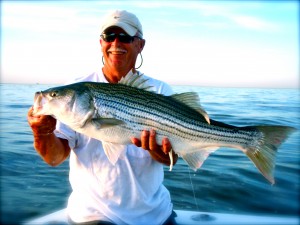 The good news is that those migratory fish I talked about last week – you know, the ones that sneak in through the C&D canal every October – well, they’re here. Since last Tuesday, reports of big, clean fish with sea lice have been flooding in. The bad news is that the Upper Chesapeake Bay is still so murky that those big stripers are moving quickly down the channel searching for cleaner water and more plentiful bait fish. They haven’t gone too far south, but they have bypassed the northern humps and ledges where we’ve found them in years past. The ugly part is that, since those fish showed up in some very accessible high-traffic areas, word got out quickly and a bite that traditionally lasts until the end of October shut down in just a few days. At the end of last week, fishing was very good, but soon hoards of inexperienced fishermen, some with screaming kids, running engines, and blaring radios, descended on an area that is shorter and narrower than a football field. That caused the fish to hunker down and become very difficult to catch. Difficult, but not impossible. It’s been a tough week, but there are trophy stripers in our area right now, and fishing is sure to improve as more and more migratory fish enter the Chesapeake.
The good news is that those migratory fish I talked about last week – you know, the ones that sneak in through the C&D canal every October – well, they’re here. Since last Tuesday, reports of big, clean fish with sea lice have been flooding in. The bad news is that the Upper Chesapeake Bay is still so murky that those big stripers are moving quickly down the channel searching for cleaner water and more plentiful bait fish. They haven’t gone too far south, but they have bypassed the northern humps and ledges where we’ve found them in years past. The ugly part is that, since those fish showed up in some very accessible high-traffic areas, word got out quickly and a bite that traditionally lasts until the end of October shut down in just a few days. At the end of last week, fishing was very good, but soon hoards of inexperienced fishermen, some with screaming kids, running engines, and blaring radios, descended on an area that is shorter and narrower than a football field. That caused the fish to hunker down and become very difficult to catch. Difficult, but not impossible. It’s been a tough week, but there are trophy stripers in our area right now, and fishing is sure to improve as more and more migratory fish enter the Chesapeake.
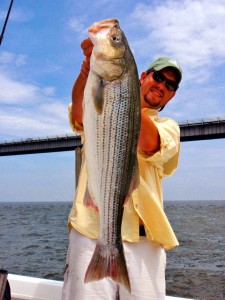 Have you heard? Light tackle casting is producing big fish lately on the Chesapeake Bay. Some lucky anglers are catching fish over 30-inches on almost every trip. Sometimes they get three or four. Most of the fish I’m catching are coming off cover like rocks or bridge pilings, but some have been hooked while fishing submerged structure in open water. Both soft plastics and metal jigs are producing. If you’ve been out, I hope you’re enjoying some lucky days. 30-inch plus stripers in late June is something to celebrate, especially considering how tough fishing has been previously.
Have you heard? Light tackle casting is producing big fish lately on the Chesapeake Bay. Some lucky anglers are catching fish over 30-inches on almost every trip. Sometimes they get three or four. Most of the fish I’m catching are coming off cover like rocks or bridge pilings, but some have been hooked while fishing submerged structure in open water. Both soft plastics and metal jigs are producing. If you’ve been out, I hope you’re enjoying some lucky days. 30-inch plus stripers in late June is something to celebrate, especially considering how tough fishing has been previously.
In my opinion, seasoned anglers make a lot of their own luck. Since the fish are more inclined to bite now, I thought it might be worthwhile to discuss tips for hooking and landing bigger fish – just some little things that can move fishermen up from the usual summer schoolies to true summer trophies. You probably have a few tips as well, so feel free to share them in the comments section. I’ll start with the basics: Read More!


